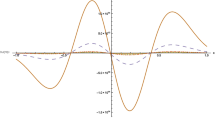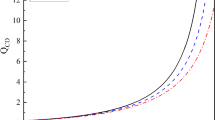Abstract
Alfvén continua and Alfvén eigenmodes (AEs) in DIII-D plasmas (shot #142111) have been studied using a drift-MHD model with self-consistent plasma diamagnetic drift effects. It is shown that the \(\omega _*\) causes the frequency upshift in ion diamagnetic drift direction for both Alfvén continua and AEs and thus breaks the ion-electron symmetry of the ideal-MHD model results. The BAE gaps are more sensitive to the \(\omega _*\) modification compared to the TAE gaps located in a higher frequency range. After comparing with self-consistent results, an approximate solution of Alfvén continua with \(\omega _*\) effect is given with high accuracy. The eigenmode structure of TAE is less influenced by \(\omega _*\) effect compared to the real frequency. The incorporation of the diamagnetic drift effects of the background plasmas and energetic particles (EPs) is important to validate theoretical and simulation models against experiments, i.e., correctly address the continuum and radiative dampings as well as AE resonance condition with EPs.







Similar content being viewed by others
References
W.W. Heidbrink, Basic physics of Alfvén instabilities driven by energetic particles in toroidally confined plasmas. Phys. Plasmas 15, 055501 (2008)
W.W. Heidbrink, Mechanisms of energetic-particle transport in magnetically confined plasmas. Phys. Plasmas 27, 030901 (2020)
W. Deng, Z. Lin, I. Holod, Gyrokinetic simulation model for kinetic magnetohydrodynamic processes in magnetized plasmas. Nucl. Fusion 52, 023005 (2012)
J. Bao, D. Liu, Z. Lin, A conservative scheme of drift kinetic electrons for gyrokinetic simulation of kinetic-MHD processes in toroidal plasmas. Phys. Plasmas 24, 102516 (2017)
W.L. Zhang, I. Holod, Z. Lin, Y. Xiao, Global gyrokinetic particle simulation of toroidal Alfvén eigenmodes excited by antenna and fast ions. Phys. Plasmas 19, 022507 (2012)
Z.X. Wang, Z. Lin, W.J. Deng, I. Holod, W.W. Heidbrink, Y. Xiao, H.S. Zhang, W.L. Zhang, M.A. Van Zeeland, Properties of toroidal Alfvén eigenmode in DIII-D plasma. Phys. Plasmas 22, 022509 (2015)
S. Taimourzadeh, E. Bass, Y. Chen et al., Verification and validation of integrated simulation of energetic particles in fusion plasmas. Nucl. Fusion 59, 066006 (2019)
C.Z. Cheng, M.S. Chance, NOVA: a nonvariational code for solving the MHD stability of axisymmetric toroidal plasmas. J. Comput. Phys. 71, 124–146 (1987)
H.R. Wilson, P.B. Snyder, G.T.A. Huysmans, R.L. Miller, Numerical studies of edge localized instabilities in tokamaks. Phys. Plasmas 9, 1277 (2002)
H.S. Xie, Y. Xiao, Parallel equilibrium current effect on existence of reversed shear Alfvén eigenmodes. Phys. Plasmas 22, 022518 (2015)
G. Fu, H. Berk, A. Pletzer, Kinetic damping of toroidal Alfven eigenmodes. Phys. Plasmas 12, 082505 (2005)
L.M. Yu, G.Y. Fu, Z.M. Sheng, Kinetic damping of Alfvén eigenmodes in general tokamak geometry. Phys. Plasmas 16, 072505 (2009)
P. Lauber, S. Günter, A. Könies, S.D. Pinches, LIGKA: a linear gyrokinetic code for the description of background kinetic and fast particle effects on the MHD stability in tokamaks. J. Comput. Phys. 226(1), 447–465 (2007)
L.J. Zheng, M.T. Kotschenreuther, P. Valanju, Diamagnetic drift effects on the low-n magnetohydrodynamic modes at the high mode pedestal with plasma rotation. Phys. Plasmas 21, 062502 (2014)
J. Bao, W. L. Zhang, D. Li, Z. Lin, A versatile MHD eigenvalue solver with self-consistently diamagnetic drift effects for simulating tokamak experiments.(submitted) (2020)
B.N. Breizman, M.S. Pekker, S. E., Sharapov and JET EFDA contributors, plasma pressure effect on Alfvén cascade eigenmodes. Phys. Plasmas 12, 112506 (2005)
Y. Xiao, I. Holod, Z. Wang, Z. Lin, T. Zhang, Gyrokinetic particle simulation of microturbulence for general magnetic geometry and experimental profiles. Phys. Plasmas 22, 022516 (2015)
G.Y. Fu, J.W. Van Dam, Excitation of the toroidicity-induced shear Alfvén eigenmode by fusion alpha particles in an ignited tokamak. Phys. Fluids B Plasma Phys. 1, 1949 (1989)
C.Z. Cheng, Kinetic extensions of magnetohydrodynamics for axisymmetric toroidal plasmas. Phys. Rep. 211(1), 1–51 (1992)
Liu Chen, Fulvio Zonca, Theory of shear Alfvén waves in toroidal plasmas. Phys. Scr. T60, 81–90 (1995)
W. Chen, X.T. Ding, Q.W. Yang et al., beta-induced Alfvén eigenmodes destabilized by energetic electrons in a tokamak plasma. Phys. Rev. Lett. 105, 185004 (2010)
J.Y. Cheng, W.L. Zhang, Z. Lin et al., Gyrokinetic particle simulation of fast-electron driven beta-induced Alfvén eigenmode. Phys. Plasmas 23, 052504 (2016)
H. Shi, W. Zhang, H. Feng, Z. Lin, C. Dong, J. Bao, D. Li, Verification of gyrokinetic particle simulation of current-driven instability in fusion plasmas. IV. Drift-tearing mode. Phys. Plasmas 26(9), 092512 (2019)
Acknowledgements
We would like to thank useful discussions with Prof. X. G. Wang, Dr. H. S. Xie and Dr. Z. X. Lu. This work is supported by Hundred Talent Program of Insititute of Physics, Chinese Academy of Sciences under Grant No. Y9K5011R21; the National Natural Science Foundation of China under Grant Nos. 11905290, 11675256 and 11675257; the External Cooperation Program of Chinese Academy of Sciences under Grant No. 112111KYSB20160039; the Strategic Priority Research Program of Chinese Academy of Sciences under Grant No. XDB16010300; National MCF Energy R&D Program under Grant Nos. 2018YFE0304100 and 2017YFE0301300; and the Key Research Program of Frontier Science of Chinese Academy of Sciences under Grant No. QYZDJ-SSW-SYS016.
Author information
Authors and Affiliations
Corresponding author
Additional information
Publisher's Note
Springer Nature remains neutral with regard to jurisdictional claims in published maps and institutional affiliations.
Derivation of Eigenmode Eq. (3) in Magnetic Coordinate
Derivation of Eigenmode Eq. (3) in Magnetic Coordinate
Assuming the eigenvector U in \(\left( \psi ,\theta ,\zeta \right)\) coordinates has the form of \(U=\sum _{m} U_m\left( \psi \right) exp\left( in\zeta -im\theta \right)\), the terms {I}–{IV} of Eq. (3) in magnetic coordinate are shown by Eqs. (6)–(9) in the following:
where \({\hat{\omega }}=\omega /\left( V_{ap}/R_0\right)\), \({\hat{\omega }}_*=\omega _*/\left( V_{ap}/R_0\right)\), \(V_{Ap} = B_a/\sqrt{4\pi n_am_p}\) is the proton Alfvén speed at magnetic axis, \(B_a\) and \(n_a\) are the magnetic field and plasma number density at magnetic axis, \(m_p\) is the proton mass, \(\rho _M=n_0m_i\) is the plasma mass density, \(g^{\psi \psi }=\nabla \psi \cdot \nabla \psi\), \(g^{\theta \theta }=\nabla \theta \cdot \nabla \theta\), and \(g^{\psi \theta }=\nabla \psi \cdot \nabla \theta\).
where \({\mathbf {B}}_{\mathbf {0}}\cdot \nabla =i\frac{q}{J}{\widetilde{k}}_m\), \(Q=\frac{1}{B_0^2}{\mathbf {B}}_{\mathbf {0}}\cdot \nabla U =i\frac{q}{JB_0^2}{\widetilde{k}}_mU_m\), and \({\widetilde{k}}_m=n-m/q\).
where the magnetic curvature \(\varvec{\kappa }=\left( \nabla \times {\mathbf {b}}_{\mathbf {0}}\right) \times {\mathbf {b}}_{\mathbf {0}}=\kappa _\psi \nabla \psi + \kappa _\theta \nabla \theta + \kappa _\zeta \nabla \zeta\), \(\kappa _\psi =\frac{1}{B_0}\frac{\partial B_0}{\partial \psi }-\frac{1}{JB_0^2}\left( \frac{\partial I}{\partial \psi }+q\frac{\partial g}{\partial \psi }\right)\), \(\kappa _\theta =\frac{gq}{JB_0^3}\frac{\partial B_0}{\partial \theta }\), and \(\kappa _\zeta =-\frac{g}{JB_0^3}\frac{\partial B_0}{\partial \theta }\). The perturbed pressure in Eq. (9) can be written as \(\delta P =\frac{i}{JB_0^2}\left( mg+nI\right) \frac{\partial P_0}{\partial \psi }U -\frac{2\Gamma P_{mhd}}{JB_0^2}\left[ i\kappa _\psi \left( mg+nI\right) +\kappa _\theta g\frac{\partial }{\partial \psi }\right] U\), \(P_0=P_{mhd}+P_{f}\) and \(\Gamma P_{mhd} = P_e + \left( 7/4\right) P_i\).
Rights and permissions
About this article
Cite this article
Bao, J., Zhang, W.L., Li, D. et al. Effects of Plasma Diamagnetic Drift on Alfvén Continua and Discrete Eigenmodes in Tokamaks. J Fusion Energ 39, 382–389 (2020). https://doi.org/10.1007/s10894-020-00275-0
Accepted:
Published:
Issue Date:
DOI: https://doi.org/10.1007/s10894-020-00275-0




